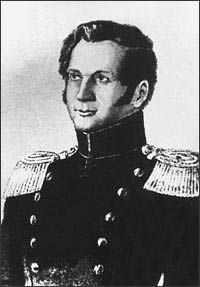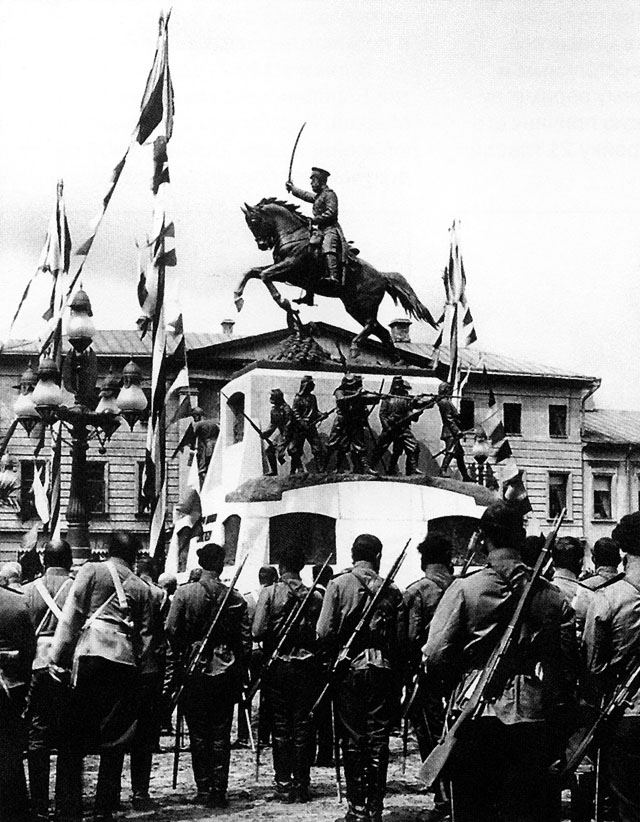|
Pavel Petrovich Anosov
Pavel Petrovich Anosov (russian: Аносов Павел Петрович) (10 July 1796 (Old Calendar, 29 June), Tver — 25 May 1851 (Old Calendar, 13 May) was a Russian mining engineer, a metallurgical scientist, a major organizer of the mining industry, a researcher of the nature of the Southern Ural, governor of Tomsk and a General-Major. His family name is Anosov, his name was Pavel and his father's name was Peter, hence the patronymic name Petrovich. Early life Anosov was the son of a petty clerk, and became an orphan at 13 years old. When his father died he left four young children as orphans: two older brothers, Peter and Pavel, and two younger sisters. The orphans took over the education of their maternal grandfather, mining official Sabakin Lev Fedorovich who was a mechanic in the Kama plants in Izhevsk and Votkinsk. The grandfather sent Pavel with his elder brother Peter to the St. Petersburg Mining Cadet Corps in 1810, during which time his brother Peter died. Pav ... [...More Info...] [...Related Items...] OR: [Wikipedia] [Google] [Baidu] |
Anosov
Anosov (masculine, russian: Аносов) or Anosova (feminine, russian: Аносова) is a Russian surname. Notable people with the surname include: * Anosov Pavel Petrovich (russian: Аносов Павел Петрович) () - Russian scientist-metallurgist *Dmitri Anosov (1936–2014), Russian Soviet mathematician ** Anosov diffeomorphism *Nikolai Anosov :''To be distinguished from Anosov Nikolai Pavlovich (1835–1890), head engineer of Amur District.'' Nikolai Pavlovich Anosov (russian: Никола́й Па́влович Ано́сов; – 2 December 1962) was a Soviet conductor and pedagog ... (1900–1962), Soviet conductor * Vitaly Anosov (born 1977), Uzbekistani canoeist {{surname, Anosov ''Metallurg Anosov'', later renamed to ''Anosov'' - Soviet merchant freighter, tweendecker, one of the Leninsky Komsomol class of cargo ships. This cargo ship was buil in 1959. Russian-language surnames ... [...More Info...] [...Related Items...] OR: [Wikipedia] [Google] [Baidu] |
SS Metallurg Anosov
The SS ''Metallurg Anosov'' (Russian: ''Металлург Аносов'') was a merchant ship of Black Sea Shipping Company (Soviet Union). the ship was one of the project 567K Leninsky Komsomol class cargo ships, ''Leninsky Komsomol class'', a multi-purpose tweendecker Cargo ship, freighter with steam turbine engines. The ship takes its name from scientist and metallurgist Pavel Petrovich Anosov, Pavel Anosov. Specifications Modifications The SS ''Metallurg Anosov'' was one of the four Leninsky Komsomol-class cargo ship, ''Leninsky Komsomol''-class cargo ships specially equipped for troop and weapon transportation. The overall length of these transports was increased by , along with size increases to the cargo hold widths, depths and bay doors. These modifications allowed the class to be used as a missile carrier. Engines The main engines were made at the Kirov Plant (Leningrad, USSR), and were installed in the Kherson shipyard. The engines produced 13000/14300 horsepower at 10 ... [...More Info...] [...Related Items...] OR: [Wikipedia] [Google] [Baidu] |
Statue Of Yuriy Dolgorukiy, Moscow
The Statue of Yuriy Dolgorukiy is an equestrian statue which commemorates the founding of Moscow in 1147 by Yuriy Dolgorukiy (1099 1157). Dolgorukiy was the Grand Prince (''Velikiy Knyaz'') of the Kievan Rus' (Kiev) and a member of the Rurik dynasty. On 6 June 1954, the statue was erected on Soviet Square (now ), located in front of the Mossoviet building (now the building of the Mayor of Moscow). The sculptors were Sergei Mikhailovich Orlov, A. P. Antropov, and Nicholay Lvovich Shtamm. The architectural design was by . The statue replaced the , which had been demolished in 1941. Skobelev statue The original statue erected in 1912 in Tverskaya Square was of General Mikhail Skobelev, a hero of the Russian-Turkish War of 1877. The depicted him mounted on his horse. The monument was known as "The White General". Skobelev wore a white parade tunic and rode a white horse into battle. He was also a member of the Tsar's military force and therefore a "White". Following the Octo ... [...More Info...] [...Related Items...] OR: [Wikipedia] [Google] [Baidu] |
Statue Of Metallurgist Anosov, Zlatoust
The ''Statue of Metallurgist Anosov'' in Zlatoust city is situated on the main square of the historical center of Zlatoust, Chelyabinsk Oblast in Russia.The statue was erected in honor of Russian General-Major, metallurgist and governor of the Ural District, Anosov Pavel Petrovich, and unveiled on 19 December 1954. It was created by Moscow sculptors A.P. Antropov, N.L. Shtamm, and architect T.L. Shulgina. Памятник П. П. Аносову."> Златоуст. >> Памятник П. П. Аносову./ref> Description The bronze statue is mounted on a massive pedestal of red Ukrainian granite, and is high, the statue itself being . Anosov Pavel Petrovich is depicted standing in the uniform of a general-major of the Mining Corps, with a curved strip of Damascus steel held between his hands. A microscope is placed on the post on the left of the statue, on the same tall pedestal. The pedestal is a cylindrical shape, which rests on a square plinth. The inscription on the ... [...More Info...] [...Related Items...] OR: [Wikipedia] [Google] [Baidu] |
Statue Of Graf Vorontsov, Odessa
The Statue of Graf Vorontsov, Odessa, is a sculptural monument established in 1863 on the Sobor Square in Odesa in honor of Mikhail Semyonovich Vorontsov, Field Marshal, the General-Governor of Novorossiya Region and plenipotentiary governor of Bessarabia who was a graf until 1845, then knyaz from 1845. The sculptor is Friedrich Brugger, the pedestal was made under the command of Sevastopol 1st guild merchant P.A. Telyatnikov. История сооружения памятника графу М.С.Воронцову."> Город-герой Одесса. ODESSKIY.COM >> История сооружения памятника графу М.С.Воронцову./ref> and the architect was Francesco Carlo Boffo. Памятник графу М.С. Воронцову. >> Описание."> Одесские достопримечательности. >> Памятник графу М.С. Воронцову. >> Описание./ref> It was the second monument in Odesa after the ... [...More Info...] [...Related Items...] OR: [Wikipedia] [Google] [Baidu] |
Kharkov University
The Kharkiv University or Karazin University ( uk, Каразінський університет), or officially V. N. Karazin Kharkiv National University ( uk, Харківський національний університет імені В. Н. Каразіна), is one of the major universities in Ukraine, and earlier in the Russian Empire and Soviet Union. It was founded in 1804 through the efforts of Vasily Karazin becoming the second oldest university in modern-day Ukraine. History Russian Empire On , the Decree on the Opening of the Imperial University in Kharkiv came into force. The university became the second university in the south of the Russian Empire. It was founded on the initiative of the local community with Vasily Karazin at the fore, whose idea was supported by the nobility and the local authorities. Count Seweryn Potocki was appointed the first supervisor of the university, the first rector being the philologist and philosopher Ivan Rizhsky. In 1 ... [...More Info...] [...Related Items...] OR: [Wikipedia] [Google] [Baidu] |
Kazan University
Kazan (Volga region) Federal University (russian: Казанский (Приволжский) федеральный университет, tt-Cyrl, Казан (Идел буе) федераль университеты) is a public research university located in Kazan, Russia. Founded in 1804 as Imperial Kazan University, astronomer Nikolai Ivanovich Lobachevsky served there as the rector from 1837 until 1876. In 1929, the university was renamed in honour of its student Vladimir Ilyich Ulyanov (Lenin). The university is known as the birthplace of organic chemistry due to works by Aleksandr Butlerov, Vladimir Markovnikov, Aleksandr Arbuzov, and the birthplace of electron spin resonance discovered by Evgeny Zavoisky. In 2011, Kazan University received a federal status. It is also one of 18 Russian universities that were initially selected to participate in the Project 5-100, coordinated by the Government of the Russian Federation and aimed to improve their international compet ... [...More Info...] [...Related Items...] OR: [Wikipedia] [Google] [Baidu] |
Steel
Steel is an alloy made up of iron with added carbon to improve its strength and fracture resistance compared to other forms of iron. Many other elements may be present or added. Stainless steels that are corrosion- and oxidation-resistant typically need an additional 11% chromium. Because of its high tensile strength and low cost, steel is used in buildings, infrastructure, tools, ships, trains, cars, machines, electrical appliances, weapons, and rockets. Iron is the base metal of steel. Depending on the temperature, it can take two crystalline forms (allotropic forms): body-centred cubic and face-centred cubic. The interaction of the allotropes of iron with the alloying elements, primarily carbon, gives steel and cast iron their range of unique properties. In pure iron, the crystal structure has relatively little resistance to the iron atoms slipping past one another, and so pure iron is quite ductile, or soft and easily formed. In steel, small amounts of ... [...More Info...] [...Related Items...] OR: [Wikipedia] [Google] [Baidu] |
Middle Ages
In the history of Europe, the Middle Ages or medieval period lasted approximately from the late 5th to the late 15th centuries, similar to the post-classical period of global history. It began with the fall of the Western Roman Empire and transitioned into the Renaissance and the Age of Discovery. The Middle Ages is the middle period of the three traditional divisions of Western history: classical antiquity, the medieval period, and the modern period. The medieval period is itself subdivided into the Early, High, and Late Middle Ages. Population decline, counterurbanisation, the collapse of centralized authority, invasions, and mass migrations of tribes, which had begun in late antiquity, continued into the Early Middle Ages. The large-scale movements of the Migration Period, including various Germanic peoples, formed new kingdoms in what remained of the Western Roman Empire. In the 7th century, North Africa and the Middle East—most recently part of the Ea ... [...More Info...] [...Related Items...] OR: [Wikipedia] [Google] [Baidu] |
Damascene Steel
Damascus steel was the forged steel of the blades of swords smithed in the Near East from ingots of Wootz steel either imported from Southern India or made in production centres in Sri Lanka, or Khorasan, Iran. These swords are characterized by distinctive patterns of banding and mottling reminiscent of flowing water, sometimes in a "ladder" or "rose" pattern. Such blades were reputed to be tough, resistant to shattering, and capable of being honed to a sharp, resilient edge. Wootz (Indian), Pulad (Persian), Fuladh (Arabic), Bulat (Russian) and Bintie (Chinese) are all names for historical ultra-high carbon crucible steel typified by carbide segregation. "Wootz" is an erroneous transliteration of "utsa" or "fountain" in Sanskrit, however since 1794 it has been the primary word used to refer to historical hypereutectoid crucible steel. History Origins The origin of the name "Damascus Steel" is contentious: the Islamic scholars al-Kindi (full name Abu Ya'qub ibn Ishaq al-K ... [...More Info...] [...Related Items...] OR: [Wikipedia] [Google] [Baidu] |
General
A general officer is an officer of high rank in the armies, and in some nations' air forces, space forces, and marines or naval infantry. In some usages the term "general officer" refers to a rank above colonel."general, adj. and n.". OED Online. March 2021. Oxford University Press. https://www.oed.com/view/Entry/77489?rskey=dCKrg4&result=1 (accessed May 11, 2021) The term ''general'' is used in two ways: as the generic title for all grades of general officer and as a specific rank. It originates in the 16th century, as a shortening of ''captain general'', which rank was taken from Middle French ''capitaine général''. The adjective ''general'' had been affixed to officer designations since the late medieval period to indicate relative superiority or an extended jurisdiction. Today, the title of ''general'' is known in some countries as a four-star rank. However, different countries use different systems of stars or other insignia for senior ranks. It has a NATO ran ... [...More Info...] [...Related Items...] OR: [Wikipedia] [Google] [Baidu] |



.jpg)

